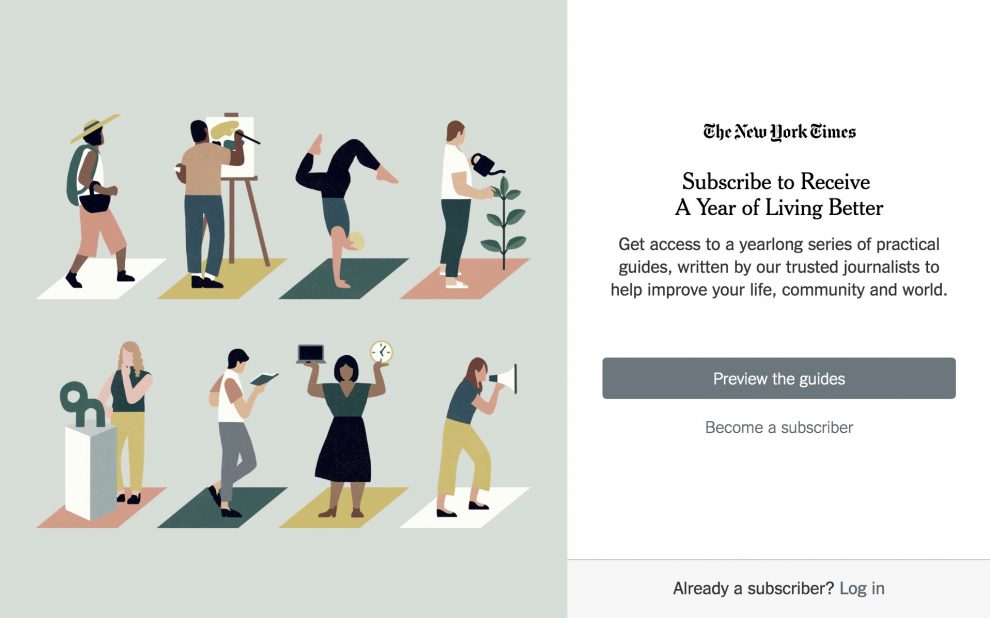
Do you want to make the world a better place? Would you like a how-to guide for that?
The New York Times is seizing on its audience’s “constant thirst for self-improvement,” in the words of Sara Bremen Rabstenek, the Times’ reader experience product director. The Times is creating a series of guides for improving various aspects of one’s life in what it’s calling A Year of Living Better, unveiling a new guide each month of 2018. Topics range from thinking about money written by financial-planning columnist Carl Richards, to “How to Find Yourself Somewhere Else” by assistant managing editor and former travel editor Monica Drake, to, yes, making the world a better place by human rights and global affairs columnist Nicholas Kristof.
“It’s ‘how to tap your inner reader’ as opposed to simply ‘how to read more books.’ It’s tapping into the need that Times readers seem to have to grow and be better and become better people,” said Karen Barrow, the Times’ senior editor of Smarter Living, who led the editorial side of the project.
The catch? Unlike other Times guides, you have to be a paying subscriber to see these — no meter involved.
“We are really keen on making a subscription seem more and more valuable to readers, both to people who are already subscribing, and people who are not subscribers who we want to give more reasons to subscribe,” said Ben Cotton, the Times’ executive director of customer experience and retention. Some efforts to “surprise and delight” subscribers are done on a one-time basis, but the company is most enthusiastic about “promising more to come over the course of the year or multiple years,” Cotton said. “It’s valuable to be able to say to subscribers: ‘This is something we’re going to be working on over the course of the whole year. You should really stick around.’”
The Times has had success — 2.6 million paying customers — with its current, metered paywall model, which is built around letting readers sample the Times’ work (up to 5 articles a month currently) and then asking for cash to see more. These guides are the first original Times content under the current paywall setup that absolutely requires a logged-in subscriber.(That’s excluding content that has been offered as part of an add-on subscription, like Times Premier or Cooking. And some content was paying-subscribers-only during the Times’ earlier paywall, TimesSelect, which ran from 2005 to 2007.)

The section has developed a handful of new products designed around a new editorial strategy: to create deeper, more personal relationships with readers as they look for guidance about “the many different health journeys happening at a given time in their lives,” Well editor Tara Parker-Pope told me. “People are thinking about the idea of health with every small decision they make on a daily basis”…
Beta — which has also produced the Times’ Cooking app, its NYT Now news app (R.I.P.), and its TV and film recommendation newsletter product Watching — was formed to create products that both solve problems for readers and build sticky relationships with them by giving them reason to back day after day.
But hitching wellbeing to subscription status is new. “This is all about how we can provide subscribers with the type of content that makes them feel like they’re getting insight they’re not getting anywhere else,” Rabstenek said
“We hear from subscribers all the time that they like the aspirational nature, that reading the Times regularly makes them feel more informed, and that they can be the best version of themselves,” Cotton said. “We see reinforcing that value through this series as really worthwhile, from a subscription standpoint.”
Publishing the guides over twelve months sets up a regular cadence for both subscribers and writers/editors of the guides. Drake’s travel-focused guide will run in May as people begin summer vacations, for example, and there’s a guide on reducing your carbon footprint by Livia Albeck-Ripka planned for April, the month of Earth Day. Anyone can Google “how to be creative” or “how to make the world a better place” and get thousands of listicles (or WikiHows), but the team is betting on the writers’ expertise and reputations as well as the sentiment of the year-long initiative to differentiate the content.
The topics are meant to “tap into the mission of each desk,” Barrow said, and are structured as if a writer was doing a series on their beat but condensed into an actionable one-stop shop. “We try to break it up into a few different sections to make it less like a standard article and more scannable, with more pullout tips,” she said. “We’re letting our writers be a little bit more personal in their guides. It’s truly Matt Richtel telling us how to be more creative, as opposed to a more nuanced, journalistic approach.”
The idea for the guides was the product of collaboration across the marketing, product, and editorial teams. The ultimate goal is subscription growth and retention (and maybe making the world a better place along the way?), and the project’s success will be measured through email open and clickthrough rates, the time readers spend on the guide pages, conversion rates based on communication to non-subscribers about the project, and retention rates for those who engage with it.
Beyond just paywalls, “we are keen to understand if there are other things to increase the differentiation between a subscriber and a regular reader,” Cotton said.